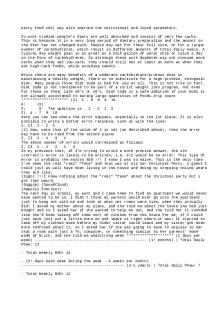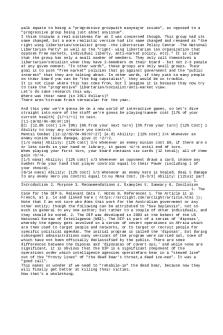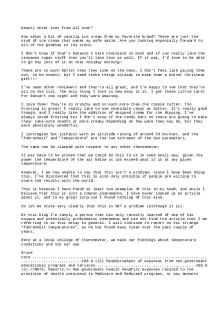Blockbuster analysis PDF

| Title | Blockbuster analysis |
|---|---|
| Author | Duong Nguyen |
| Course | Tourism Geography |
| Institution | IMC Fachhochschule Krems |
| Pages | 8 |
| File Size | 204.2 KB |
| File Type | |
| Total Downloads | 89 |
| Total Views | 144 |
Summary
Introduction on Finance...
Description
Blockbuster LLC and its major problem regarding leadership Blockbuster LLC was a provider focusing on the rental service of movie and video game tapes, later expanded to several services including mail – delivering DVDs, streaming, customized videos and cinematic experiences. According to Sloan (2020), the company started its international business expansion through the 90s, operating in over 2800 locations and reaching an all – time peak in 2004 with 9094 rental stores in total around the globe and approximately 84,300 workers (58,500 people within the United States’ territory and 25,800 people overseas). Unfortunately, during the 1997 – 2006 period, which also known as the John Antioco era in Blockbuster’s management history, the label was witnessed to fall in a state of disruption after several legal accusations against its “no late fees” policy, losing financial support from the aforementioned extended – viewing profit and unsuccessful merging deal with Hollywood Entertainment Inc. According to Satell (2014), the company started to encounter business failure when profit went down in the late 2000s and finalized with a bankruptcy declaration in 2010, leading to the situation in which 1700 remaining stores of the firm were purchased by Dish Network, a satellite TV service. During the first few months of 2014, Blockbuster’s last 300 company – owned stores were closed, putting an end to the once – glory rental empire of America. According to Satell (2014), John Antioco – the former chief executive of Blockbuster LLC during the crisis era, was held responsible for several business failures and poor leadership when eliminating the “no late fees” that did not appear to be “pleasant” to customers despite the fact that it was the main source of Blockbuster’s profit to invested significantly in an Internet – based platform in order to catch up with other rival at the time such as Netflix. Based on the article by Antioco himself on Harvard Business Review (2011), he claimed that after convincing the board to back up his plan, Jim Keyes – a board member and Antioco’s long – term business partner, has stated that the operating cost for this plan (around $400 million), including the elimination of late fees and launching the Blockbuster Online, was in fact damaging the profit of the company. Not only that, the poor management of CEO John Antioco has resulted in many losses in business venture, one of which was the failed deal with Netflix on 2000. This report would shed light on the issues and the impacts of poor leadership on the company by analysing and making a proposal for future improvement based on the eight – step decision – making model.
Negative impacts of poor leadership on the business John Antioco – the former chief executive of Blockbuster LLC during the crisis era, was held responsible for several business failures and poor leadership when eliminating the “no late fees” that did not appear to be “pleasant” to customers despite the fact that it was the main source of Blockbuster’s profit to invested significantly in an Internet – based platform in order to catch up with other rival at the time such as Netflix (Satell, 2014). Moreover, according to Randolf (2019), Antioco has rejected the business deal with Reed Hastings, the CEO of Netflix in 2000 due to the fact that he considered the sale pitch as “small fish” and not worth the offered $50 million price that Hastings expected. This would later become one of the biggest mistake Blockbuster has ever made in business venture when Netflix rapidly risen to fame with outstanding successes in finance with 6.3 million subscribers (while its Blockbuster counterpart only gained nearly half of the number) in 2006 and had sealed a deal with Starz for the streaming service for nearly 1,000 blockbuster movies and shows on its service (Dempsey, 2008). According to Satell (2014), when convinced that Netflix and Redbox – a fellow DVD rental firm, would be the threat to Blockbuster’s market, Antioco has taken advantage of his authority and power reach as the chief executive officer, along with his previous reputation and credibility when earning double revenue for the company in his year of operation, to eliminate the “no late fees” that did not appear to be “pleasant” to customers despite the fact that it was the main source of Blockbuster’s profit to invested significantly in an Internet – based platform which was Blockbuster Online. This decision has encountered the disagreement from Jim Keyes – a fellow board member when stating out the fact that Antioco’s plan has not shown any result but damaging the already worn – out profit of the company. Eventually, Carl Icahn – an essential investor of the company started to doubt Antioco’s leadership, leading to the result in which he lost the trust of the company, being replaced by Jim Keyes and was put on employment elimination with a compensation dispute in 2005. Demonstrated misuse of approach types The CEO John Antioco was the depiction of the poor leadership type with his power abuse in authority and one – sided decision regarding the organization’s business.
According to Nivedita et at. (2018), leadership styles concluded three types: the transitional, the trustworthy and the toxic. Antioco’s behavior in managing the changes in Blockbuster’s business has displayed the characteristics of the toxic leadership style, in which he possessed charm, determination but also negatively authoritative personality. This did not necessarily mean that he was a personally toxic person but had eventually harmed other stakeholders’ trust on his leadership when making unwise business venture regarding the survival of Blockbuster within the competitive market of rental services. Based on the Behavioral Leadership Theory (Levin 1930), three styles were represented leadership: Democratic, Autocratic and Laissez – faire leaders. In the case of Blockbuster’s downfall, John Antioco was categorized under the Autocratic leadership’s domain when the CEO has hastily made unwise business decisions in cutting the extended – viewing fees to invest more on the Internet – based streaming platform and eventually harming the profit as well as benefits of the company as a whole and stakeholders as personal. The eight-stage decision model for HRM solutions Despite being faced with many criticism, conflict and argument, Antioco still carried out the business venture without much notice to involved parties in the matter (Satell, 2014). This was not a responsible decision to make when leadership could affect the organization greatly and Blockbuster was the prime example for this fact when it finally filed for bankruptcy in 2010. Due to this reason, the author suggested an effective and thoughtful approach mainly based on the theory of the eight – stage decision model as below: Step 1: Identification of a Problem To prevent power abuse in managing business in work environment Step 2: Identification of Decision Criteria Reduce number of dictative approach in business management Increase the involvement of employee’s contribution in making decision Code of conduct for toxic leadership behavior Create a safe, effective and friendly work environment
Step 3: Allocation of Weights to Criteria Criterion Reduce number of dictative approach in business
Weight (10) 10
management Increase the involvement of employee’s contribution
8
in making decision Code of conduct for toxic leadership behavior Create a safe, effective and friendly work
5 10
environment
Step 4: Developing of Alternatives A1: Publish a team – working – oriented handbook and a code of conduct for dictative leadership A2: Hold team work events on a regular basis for employees and leaders to join in A3: Require an standardised code of conduct among managers in managing teams. A4: Create a complaint system in which employees could submit reports on authorship abuse in workplace and service to investigate such cases. Step 5: Analysis of Alternatives Alternatives C1 A1: Publish a 6
C2 6
C3 8
C4 8
6
5
7
team – working –
oriented
handbook and a code of conduct for
dictative
leadership A2: Hold team 8 work events on a regular basis for employees
and
leaders to join in
A3: Require an
8
8
7
9
8
10
6
7
C2 (8) 6 (48)
C3 (5) 8 (40)
C4 (10) 8 (80)
6 (48)
5 (25)
7 (70)
standardised code of conduct among managers in
managing
teams. A4: Create
a
complaint system in which employees could submit on
reports
authorship
abuse
in
workplace service
and to
investigate such cases.
Step 6: Selection of Alternatives Alternatives C1 (10) A1: Publish a 6 (60) team – working –
oriented
handbook and a code of conduct for
dictative
leadership A2: Hold team 8 (80) work events on a regular basis for employees
and
leaders to join in
A3: Require an
8 (80)
8 (64)
7 (35)
9 (90)
8 (80)
10 (80)
6 (30)
7 (70)
standardised code of conduct among managers in
managing
teams. A4: Create
a
complaint system in which employees could submit on
reports
authorship
abuse workplace service
in and to
investigate such cases.
According to the aforementioned evaluation, the 2 most effective solutions for Blockbuster LLC were: A3: Require an standardised code of conduct among managers in managing teams. A4: Create a complaint system in which employees could submit reports on authorship abuse in workplace and service to investigate such cases. Step 7: Implementing the Alternatives For A3 to be materialized into reality, Blockbuster LLC should be able to notice the managers on a reward system in which managers would receive an incentive bonus if no submitted complaints were directed to them under a monthly or yearly time. Moreover, a feedback made from several involved parties from all hierarchies within the company’s functional system would be useful in making evaluation and coming up with solutions.
For A4 to be materialized into reality, Blockbuster LLC should assemble a team of third – party members who would not be bribed by managers when it came to making decisions and judgements on the leadership behavior towards surbodinates in workplace. Step 8: Evaluation of Decision Effectiveness The final result of the eight – stage decision plan should be as below: ● The number (%) of power abuse cases reduced ● The number (%) of power – oppressed victims are protected from career sabotage and revenge oppression in workplace. ● The number of conducted team - oriented activities ● The number of power abuse cases investigated by the support team
Conclusion The case of Blockbuster LLC has proven the fact that leadership and HRM practices could affect an organization’s business outcome infinitely. As a leader, managing a team of dependent members as well as assuring the survival of it in the competitive market was no easy job and making mistakes was understandable. But instead of reflecting on these past failures in leadership, CEO John Atioco has ignored the urgent need to learn from mistakes and continued to carry on the unwise business plan and eventually, losing the trust of other stakeholders, which would be proven as essential for his position as Blockbuster LLC’s CEO. References 1. Sloan, M 2020, 'Netflix vs Blockbuster – 3 key takeaways,’ The Drift, 1 Jun, viewed 6
April 2021, . 2. Antioco, J 2011, ‘How I Did It: Blockbuster’s Former CEO on Sparring with an Activist
Shareholder’,
Harvard
Business
Review,
2
April,
viewed
6
April
2021,
. 3. Randolf, M 2019, ‘HE “WAS STRUGGLING NOT TO LAUGH”: INSIDE NETFLIX’S
CRAZY, DOOMED MEETING WITH BLOCKBUSTER’, Vanity Fair, Sep 19, viewed 6
April 2021, . 4. Dempsey, J 2008, ‘Netflix, Starz strike streaming deal’, Variety, Oct 1 , viewed 6 April
2021,
<
https://variety.com/2008/digital/news/netflix-starz-strike-streaming-deal-
1117993139/>. 5. Satell, G 2014, ‘A Look Back At Why Blockbuster Really Failed And Why It Didn't Have
To’,
Forbes,
Sep
5,
viewed
6
April
2021,. 6. Nivedita S., Santoshi S., Santosh D. 2018, ‘Toxic Leadership: The Most Menacing Form
of Leadership, Dark Sides of Organizational Behavior and Leadership, Maria Fors Brandebo and Aida Alvinius’, Intech Open, viewed at 6 April 2021, < https://www.intechopen.com/books/dark-sides-of-organizational-behavior-andleadership/toxic-leadership-the-most-menacing-form-of-leadership>....
Similar Free PDFs

Blockbuster analysis
- 8 Pages

Caso Blockbuster
- 2 Pages

Caso Blockbuster netflix
- 1 Pages

Caso Blockbuster - caso practico
- 11 Pages
Popular Institutions
- Tinajero National High School - Annex
- Politeknik Caltex Riau
- Yokohama City University
- SGT University
- University of Al-Qadisiyah
- Divine Word College of Vigan
- Techniek College Rotterdam
- Universidade de Santiago
- Universiti Teknologi MARA Cawangan Johor Kampus Pasir Gudang
- Poltekkes Kemenkes Yogyakarta
- Baguio City National High School
- Colegio san marcos
- preparatoria uno
- Centro de Bachillerato Tecnológico Industrial y de Servicios No. 107
- Dalian Maritime University
- Quang Trung Secondary School
- Colegio Tecnológico en Informática
- Corporación Regional de Educación Superior
- Grupo CEDVA
- Dar Al Uloom University
- Centro de Estudios Preuniversitarios de la Universidad Nacional de Ingeniería
- 上智大学
- Aakash International School, Nuna Majara
- San Felipe Neri Catholic School
- Kang Chiao International School - New Taipei City
- Misamis Occidental National High School
- Institución Educativa Escuela Normal Juan Ladrilleros
- Kolehiyo ng Pantukan
- Batanes State College
- Instituto Continental
- Sekolah Menengah Kejuruan Kesehatan Kaltara (Tarakan)
- Colegio de La Inmaculada Concepcion - Cebu











